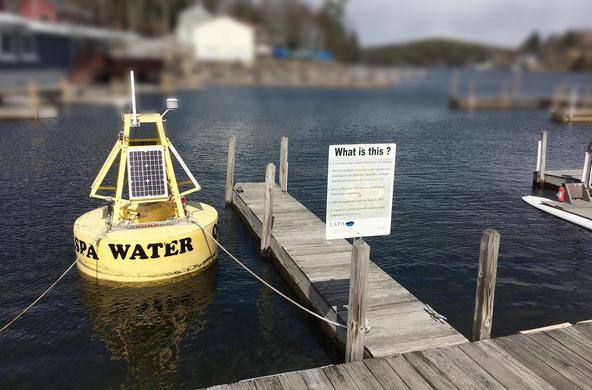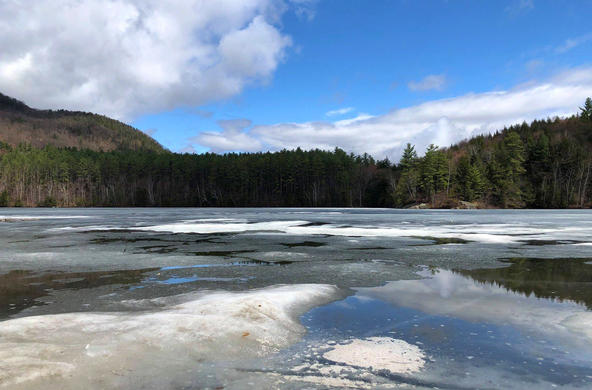Something peculiar is happening to rivers and streams in large parts of the United States — the water's chemistry is changing. Scientists have found dozens of waterways that are becoming more alkaline. Alkaline is the opposite of acidic — think baking soda or Rolaids.
Research published in the current issue of Environmental Science and Technology shows this trend to be surprisingly widespread, with possibly harmful consequences.
What's especially odd about the finding is its cause: It seems that acid rain actually has been causing waterways to grow more alkaline.
The story started back in 1963 in a New Hampshire forest. A young scientist named Gene Likens found a stream there that was as acidic as tomato juice.
Likens eventually found the culprit: acid rain. Industrial air pollution was acidifying water that rained down from the sky, killing trees and the ecosysystems of streams in the East.
Now — 50 years later — there's less acid rain. But rivers aren't neutral, they're alkaline, and that seems to be the trend in lots of places. "The real shocker to me," Likens says, "was [that] we found it from New Hampshire to Florida, and in rivers and streams that drained agricultural land, forest land, and urban land."
Two-thirds of the 97 streams and rivers his team studied in the East have been growing more alkaline — from the mighty Susquehanna to small urban streams, like Gwynns Falls in downtown Baltimore, Md.
I recently visited Gwynns Falls with one of Likens' team members, Sujay Kaushal, a geologist from the University of Maryland. He guided me down to the stream, directly below an overpass of Interstate 95. It's anything but bucolic. Traffic roars overhead, and there's trash in the stream, and plastic bags hanging from the lower limbs of trees along the banks.
This stream is where Kaushal first found signs of rising alkalinity about six years ago, after a local water quality official told him he'd been noticing changes in water chemistry.
"We couldn't explain it," Kaushal says. Initially the scientists thought maybe the concrete and cement of pavement, highway overpasses or other structures were to blame. "One of key ingredients of concrete is actually limestone," he says, and the mix of water and limestone release bicarbonate — essentially the same stuff that remedies acid indigestion.
But when Kaushal and Likens looked at waterways outside cities — running through forests, for example, or farmland — they found that these rural rivers and streams have been growing more alkaline over the last 25 years, too.
Acid rain is largely behind the phenomenon, the scientists say. It's been eating away chunks of rock, especially limestone rock, and the runoff produces carbonates that flow into rivers. "We're basically dissolving the surface of the Earth," says Kaushal. "It's ending up in our water. It's like rivers on Rolaids. There's a natural antacid in these watersheds."
Now that's not an immediate health threat, but it has environmental effects. Kaushal invited me to wade into the stream. Mops of stringy green stuff coated the rocks. It was thick and slippery underfoot.
"You can feel that?" he asks. "All that scum, all that slime is algae and bacteria." The alkalinity stimulates the growth of certain types of algae. And too much algae will suck the oxygen out of the water — bad news for whatever else lives there.
Something else is worrisome about alkaline water: If it mixes with sewage, it creates a particularly toxic stew by converting ammonia in the sewage into a more toxic form.
It just so happens, the day I visited Gwynns Falls, there was a sewage leak just upstream that Kaushal was eager to show me. "So ... why don't we walk up along this?" He seemed disappointed when I declined to observe sewage chemistry first hand. I took his word for it.
Gwynns Falls is a small stream, and it doesn't take a lot to alter its chemistry. But even big rivers that usually can dilute moderate levels of noxious pollutants are growing more alkaline.
"We've changed the chemistry of the Mississippi," says Peter Raymond, an ecologist at Yale University. "These aren't small systems."
Some of the growing alkalinity of the Mississippi and its tributaries comes from farmers putting lime on fields to counteract the acidity produced by fertilizers, Raymond says. Acid rain likely contributes, too.
He says it's not clear what kind of damage all this is doing, though a number of freshwater organisms are likely to be affected. "Some will be winners and some will be losers," Raymond says.
If there's any good news here, it's this: There's less acid rain falling now. Still, it's enough, says Gene Likens, to keep eating away the rock. Likens, now at the Cary Institute of Ecosystem Studies in Millbrook, N.Y., says he never dreamed acid rain would have such a long reach. "The impacts are large," he says, "larger than we ever thought 50 years ago they might be."






